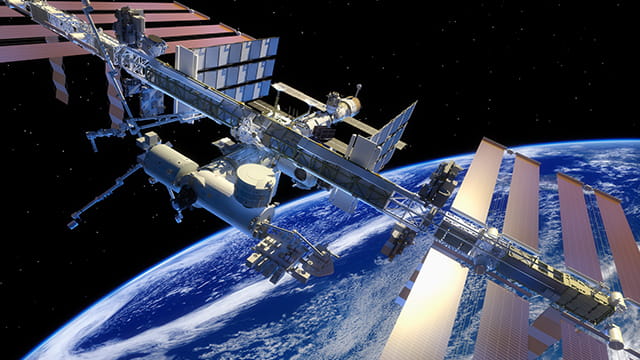Spaceflight-Associated Neuro-Optical Syndrome (SANS) Expert Identifies Top Medical Challenges Associated with Mars Voyage
Nov. 2, 2023 - Eden McCleskeyWith less than a decade to go before NASA's stated goal of sending the first crewed mission to Mars, researchers across the globe are racing to identify — and solve — any roadblocks that remain in the way.
It's not just the lack of intergalactic gas stations that has them worried. A slew of potential health concerns also face the individuals tasked with making the longest and furthest trek into space thus far.
Dr. Andrew G. Lee, the Herb and Jean Lyman Centennial Chair of Ophthalmology at Houston Methodist Hospital and the Blanton Eye Institute, is an internationally recognized expert in spaceflight-associated neuro-optical syndrome, or SANS, a condition that causes temporary vision degradation while in space.
Dr. Lee and colleagues recently co-authored a study published in the journal Cells that sheds light on SANS and other unique health risks that astronauts face on extended spaceflights.
"I would say by far the most pressing concern is radiation," Dr. Lee said. "Spacecraft and astronauts en route to Mars are vulnerable to bombardment with high-energy galactic cosmic particles and other forms of radiation that they would never be exposed to on Earth because we are shielded by a protective magnetosphere."
Second on the list of concerns that NASA scientists and their research partners share is the effect of prolonged weightlessness on bodily fluids.
Without Earth's gravitational pull, bodily fluids float upward, causing an increase in intravascular, intracranial, intraorbital and intraocular pressures. Such cephalad shifts can pose significant risks to astronauts' cardiovascular and neurological systems, potentially leading to syncope upon re-entry and increasing the risk of stroke and SANS during their journey.
In the journal article, Dr. Lee and his colleagues also emphasized the psychological challenges of extended confinement.
"Right now, there's a team of astronauts simulating the experience of a Mars mission, including living for six months in a Mars-mission-sized habitat that they cannot leave," Dr. Lee said. "Though the experiment doesn't replicate the weightlessness or radiation risks, it is a critical test for the mental and physical resilience that will be needed during prolonged confinement and close quarters."
Addressing these three primary health challenges requires innovation.
In collaboration with NASA, Houston Methodist Hospital is studying techniques and technology for artificial intelligence-enabled portable, lightweight, wearable medical consultation devices that they hope will be ready in time for Mars deployment. Due to an eight-minute communication delay between Earth and Mars, real-time medical consultations would be nearly impossible, making such AI-enabled devices useful.
Additionally, to combat potential vision issues related to SANS, a miniaturized wearable goggle that can noninvasively measure visual acuity and track intracranial pressure is under development. The device will utilize available off-the-shelf technology like Oculus and open-source AI to ensure astronauts' eye and brain health remain stable.
While such solutions are underway, unpredictable elements remain.
"High energy galactic radiation from supernovas, solar particle events from solar flares and coronal mass ejections containing high-energy charged particles are almost entirely random, and they are so powerful a single burst could be dangerous to astronauts," Dr. Lee explained.
With regard to the risks of elevated fluid pressure, Dr. Lee says that although certain medicines, like acetazolamide (Diamox), do exist to reduce optic disc edema, their use comes with side effects like increased fatigue and risk of kidney stones — complications no astronaut would want to face in space.
"If a medical emergency happens to an astronaut on the International Space Station, they can get into the Soyuz lifeboat and be home in a day or two," Dr. Lee explained. "On this trip, you would be too far away to return home; whatever treatment is accessible on board is your only option."
Adding to the complexity of longer, deeper space voyages is the risk posed by SANS.
"Historically, over 60% of astronauts who have been to space develop SANS, a condition that gets worse with cumulative exposure to zero gravity," Dr. Lee said. "If someone has already been to space and experienced SANS, it might disqualify them from future Mars missions. But that's a real catch-22 because it means sidelining many of our best and most experienced astronauts."
In the coming decade, many tough decisions will have to be made regarding the feasibility of the voyage and the best equipment and candidates to send on the historic journey.
"Thankfully, it's not me making these decisions," Dr. Lee said, though he does acknowledge that the research he and his colleagues are conducting will play a pivotal role in informing these decisions.
The road to Mars is fraught with challenges, not unlike the 1950s-1960s technology-powered first trips to the moon.
The collaboration between NASA and institutions like Houston Methodist Hospital, however, should help pave the way towards ensuring the safety and success of the ambitious expedition.
"It's about human curiosity, our drive for exploration, endurance and understanding the risks, while being as prepared as we possibly can be for all future space missions including Mars," Dr. Lee summarized.


